

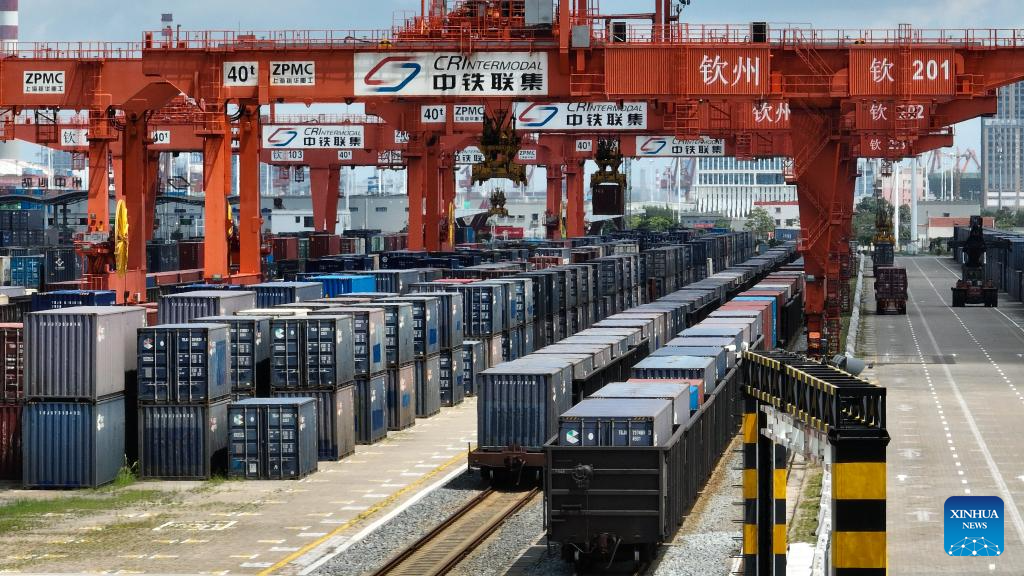
A drone photo taken on July 3, 2025 shows gantry cranes loading containers onto a freight train in Qinzhou railway container center station in south China's Guangxi Zhuang Autonomous Region. Cargo volume on the New International Land-Sea Trade Corridor surged 76.9 percent year on year to 746,000 twenty-foot equivalent units (TEUs) in the first six months of this year, according to the China Railway Nanning Group. The corridor now operates 14 fixed train routes connecting Beibu Gulf Port in Guangxi and Zhanjiang Port in neighboring Guangdong Province to major inland hubs including Chongqing, Chengdu, Guiyang, Lanzhou, Huaihua and Xi'an. Goods transported through the trade corridor via intermodal rail-sea service now cover 1,236 categories, 79 more than a year earlier, spanning electronics, vehicles and auto parts, machinery, household appliances, and food. (Xinhua/Zhang Ailin)
NANNING, July 3 (Xinhua) -- Cargo volume on the New International Land-Sea Trade Corridor surged 76.9 percent year on year to 746,000 twenty-foot equivalent units (TEUs) in the first six months of this year, according to the China Railway Nanning Group.
Cargo flow along the corridor hit a new record by reaching the 700,000 TEU mark on June 20, 125 days earlier than it did last year. As an important project under the Belt and Road Initiative, it has been playing a key role in connecting China's landlocked western regions to global markets.
A new intermodal transport model was introduced on March 25, when a freight train carrying 200 vehicles from southwest China's Chongqing Municipality arrived at Qinzhou Port in south China's Guangxi Zhuang Autonomous Region for direct transfer to an ocean vessel bound for Dubai's Jebel Ali Port. This first-time use of a "JSQ-type freight train combining a roll-on/roll-off (ro-ro) vessel" solution created a new export path for vehicles from Chongqing.
The corridor also launched integrated rail-sea logistics packages this year, reducing shippers' need to coordinate separately with multiple carriers across different transport segments, and enabling full cargo tracking to boost efficiency and lower costs.
The corridor now operates 14 fixed train routes connecting Beibu Gulf Port in Guangxi and Zhanjiang Port in neighboring Guangdong Province to major inland hubs including Chongqing, Chengdu, Guiyang, Lanzhou, Huaihua and Xi'an. Goods transported through the trade corridor via intermodal rail-sea service now cover 1,236 categories, 79 more than a year earlier, spanning electronics, vehicles and auto parts, machinery, household appliances, and food.
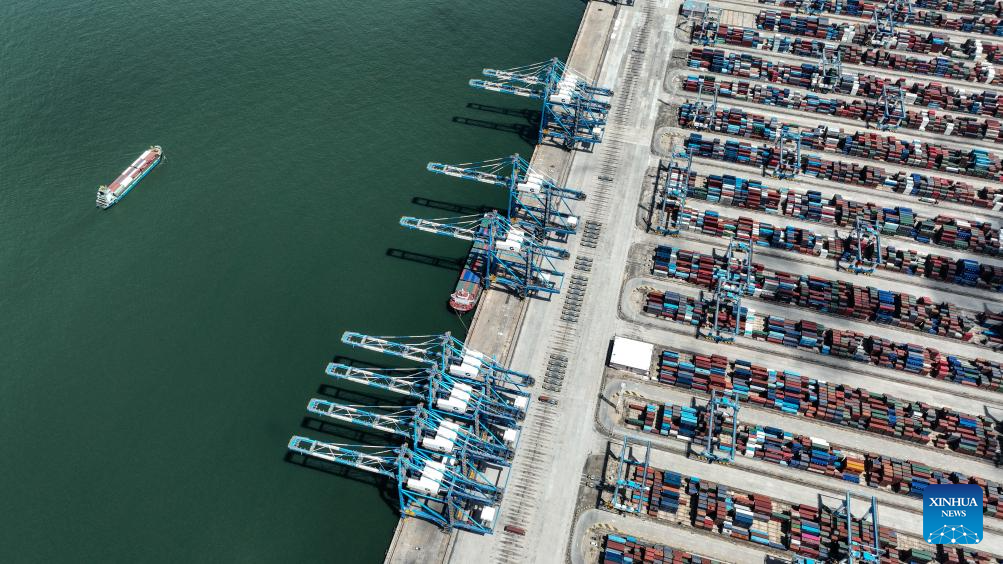
An aerial drone photo taken on July 3, 2025 shows an ocean vessel fully loaded with containers docking at an automated container terminal of Qinzhou Port, in Qinzhou City, south China's Guangxi Zhuang Autonomous Region. Cargo volume on the New International Land-Sea Trade Corridor surged 76.9 percent year on year to 746,000 twenty-foot equivalent units (TEUs) in the first six months of this year, according to the China Railway Nanning Group.
The corridor now operates 14 fixed train routes connecting Beibu Gulf Port in Guangxi and Zhanjiang Port in neighboring Guangdong Province to major inland hubs including Chongqing, Chengdu, Guiyang, Lanzhou, Huaihua and Xi'an. Goods transported through the trade corridor via intermodal rail-sea service now cover 1,236 categories, 79 more than a year earlier, spanning electronics, vehicles and auto parts, machinery, household appliances, and food. (Xinhua/Zhang Ailin)
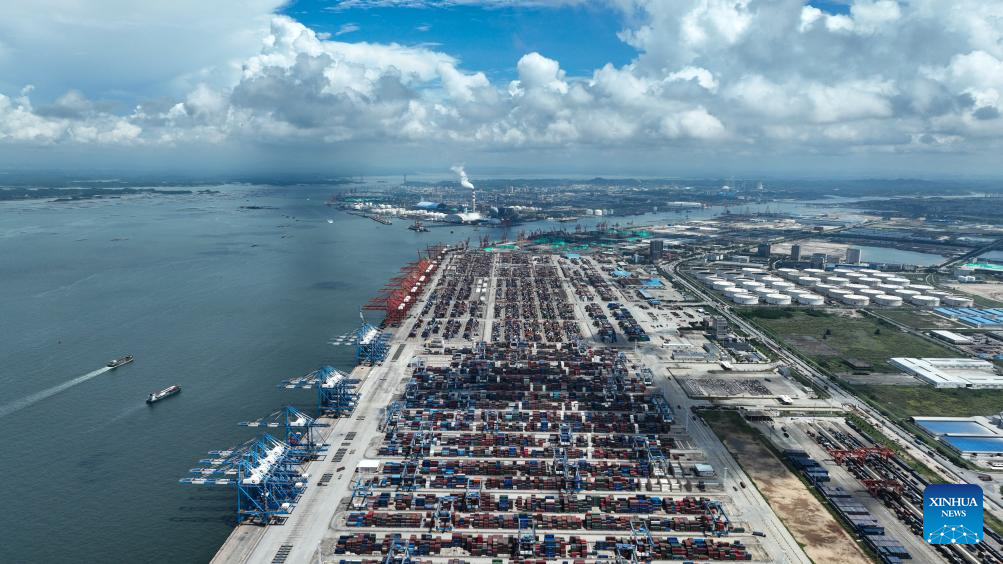
An aerial drone photo taken on July 3, 2025 shows a view of Qinzhou Port in Qinzhou City, south China's Guangxi Zhuang Autonomous Region. Cargo volume on the New International Land-Sea Trade Corridor surged 76.9 percent year on year to 746,000 twenty-foot equivalent units (TEUs) in the first six months of this year, according to the China Railway Nanning Group.
The corridor now operates 14 fixed train routes connecting Beibu Gulf Port in Guangxi and Zhanjiang Port in neighboring Guangdong Province to major inland hubs including Chongqing, Chengdu, Guiyang, Lanzhou, Huaihua and Xi'an. Goods transported through the trade corridor via intermodal rail-sea service now cover 1,236 categories, 79 more than a year earlier, spanning electronics, vehicles and auto parts, machinery, household appliances, and food. (Xinhua/Zhang Ailin)

An aerial drone photo taken on July 3, 2025 shows a container yard of an automated container terminal of Qinzhou Port in Qinzhou City, south China's Guangxi Zhuang Autonomous Region. Cargo volume on the New International Land-Sea Trade Corridor surged 76.9 percent year on year to 746,000 twenty-foot equivalent units (TEUs) in the first six months of this year, according to the China Railway Nanning Group.
The corridor now operates 14 fixed train routes connecting Beibu Gulf Port in Guangxi and Zhanjiang Port in neighboring Guangdong Province to major inland hubs including Chongqing, Chengdu, Guiyang, Lanzhou, Huaihua and Xi'an. Goods transported through the trade corridor via intermodal rail-sea service now cover 1,236 categories, 79 more than a year earlier, spanning electronics, vehicles and auto parts, machinery, household appliances, and food. (Xinhua/Zhang Ailin)
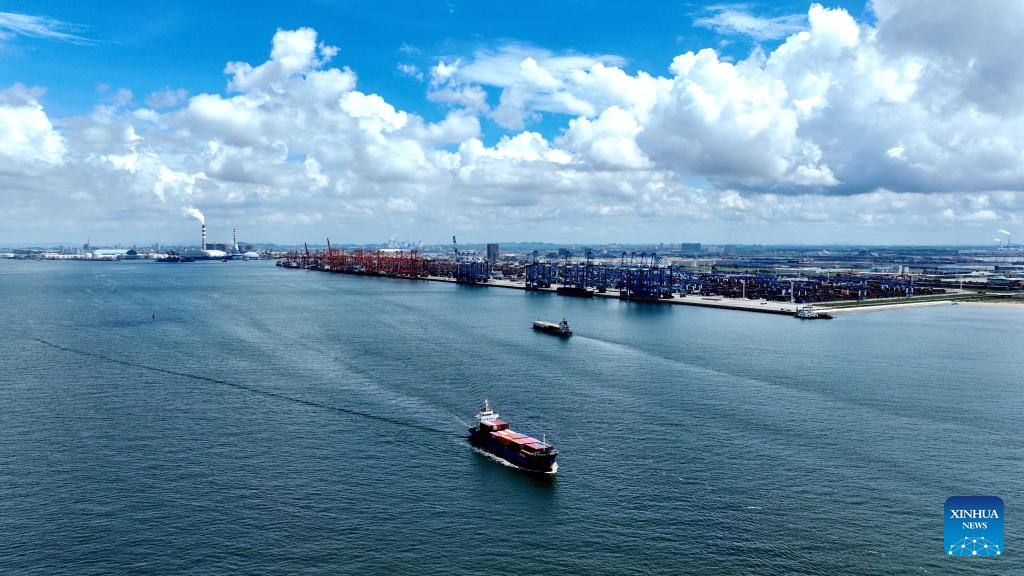
An aerial drone photo taken on July 3, 2025 shows an ocean vessel fully loaded with containers leaving Qinzhou Port, in Qinzhou City, south China's Guangxi Zhuang Autonomous Region. Cargo volume on the New International Land-Sea Trade Corridor surged 76.9 percent year on year to 746,000 twenty-foot equivalent units (TEUs) in the first six months of this year, according to the China Railway Nanning Group.
The corridor now operates 14 fixed train routes connecting Beibu Gulf Port in Guangxi and Zhanjiang Port in neighboring Guangdong Province to major inland hubs including Chongqing, Chengdu, Guiyang, Lanzhou, Huaihua and Xi'an. Goods transported through the trade corridor via intermodal rail-sea service now cover 1,236 categories, 79 more than a year earlier, spanning electronics, vehicles and auto parts, machinery, household appliances, and food. (Xinhua/Zhang Ailin)

Ancient painting "Lady Guoguo's Spring Outing" to be displayed at Liaoning Provincial Museum
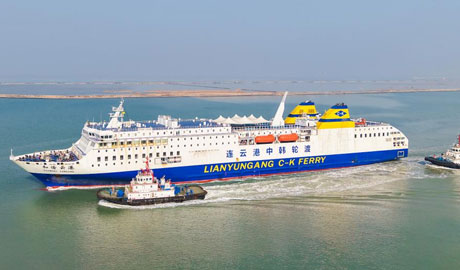
Lianyungang port welcomes largest group of S. Korean travelers under China's visa-free policy

Hall of Mental Cultivation of the Palace Museum reopens to public

Wuyi rock pigment painting in China's Fujian infuses modern artistic elements into tradition

China-Serbia digital art exhibition explores time, space, heritage
点击右上角![]() 微信好友
微信好友
 朋友圈
朋友圈

请使用浏览器分享功能进行分享
